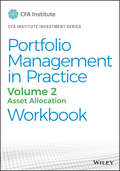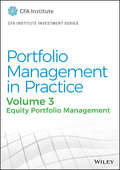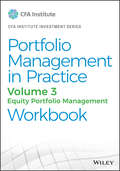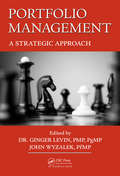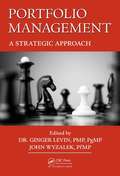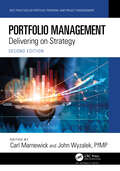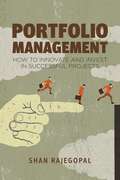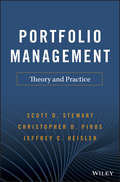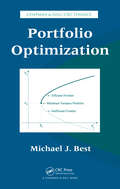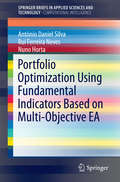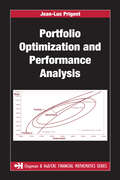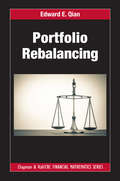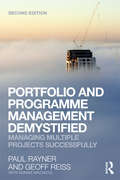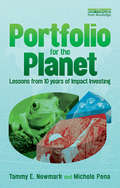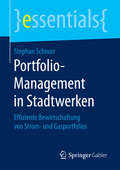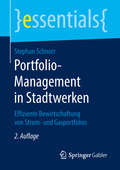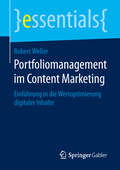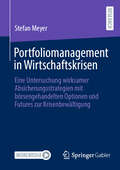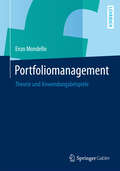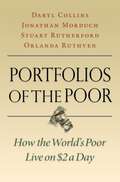- Table View
- List View
Portfolio Management in Practice, Volume 2: Asset Allocation Workbook (CFA Institute Investment Series)
by CFA InstituteThe Asset Allocation Workbook offers a range of practical information and exercises that reinforce the key concepts explored in Portfolio Management in Practice, Volume 2: Asset Allocation. Part of the reputable CFA Institute Investment Series, the workbook is designed to further students’ and professionals’ hands-on experience with a variety of learning outcomes, summary overview sections, and challenging problems and solutions. The workbook provides the necessary tools and latest information to help learners advance their skills in this critical facet of portfolio management. Aligning chapter-by-chapter with the main text so readers can easily pair exercises with the appropriate content, this workbook covers: Setting capital market expectations to support the asset allocation process Principles and processes in the asset allocation process, including handling ESG-integration and client-specific constraints Allocation beyond the traditional asset classes to include allocation to alternative investments The role of exchange-traded funds can play in implementing investment strategies The Asset Allocation Workbook has been compiled by experienced CFA members to give learners world-class examples based on scenarios faced by finance professionals every day. For practice on additional aspects of portfolio management, explore Volume 1: Investment Management, Volume 3: Equity Portfolio Management, and their accompanying workbooks to complete the Portfolio Management in Practice series.
Portfolio Management in Practice, Volume 3: Equity Portfolio Management (CFA Institute Investment Series)
by CFA InstituteDiscover the latest essential resource on equity portfolio management for students and investment professionals. Part of the CFA Institute's three-volume Portfolio Management in Practice series, Equity Portfolio Management offers a fuller treatment of active versus passive equity investment strategies. This text outlines key topics in the portfolio management process with clear, concise language to serve as an accessible guide for students and current industry professionals. Building on content in the Investment Management and Equity Valuation volumes in the CFA Institute Investment Series, Equity Portfolio Management provides an in-depth, technical examination of constructing and evaluating active equity methods. This volume explores: An overview of passive versus active equity strategies Market efficiency underpinnings of passive equity strategies Active equity strategies and developing portfolios to reflect active strategies Technical analysis as an additional consideration in executing active equity strategies To further enhance your understanding of the tools and techniques covered here, don't forget to pick up the Portfolio Management in Practice, Volume 3: Equity Portfolio Management Workbook. The workbook is the perfect companion resource containing Learning Outcomes, Summary Overview sections, and challenging practice questions that align chapter-by-chapter with the main text. Equity Portfolio Management alongside the other Portfolio Management in Practice volumesdistill the knowledge, skills, and abilities readers need to succeed in today’s fast-paced financial world.
Portfolio Management in Practice, Volume 3: Equity Portfolio Management Workbook (CFA Institute Investment Series)
by CFA InstituteThe Equity Portfolio Management Workbook provides learners with real-world problems based on key concepts explored in Portfolio Management in Practice, Volume 3: Equity Portfolio Management. Part of the reputable CFA Institute Investment Series, the workbook is designed to further students’ and professionals’ hands-on experience with a variety of Learning Outcomes, Summary Overview sections, and challenging exercises and solutions. Created with modern perspective, the workbook presents the necessary tools for understanding equity portfolio management and applying it in the workplace. This essential companion resource mirrors the main text, making it easy for readers to follow. Inside, users will find information and exercises about: The difference between passive and active equity strategies Market efficiency underpinnings of passive equity strategies Active equity strategies and constructing portfolios to reflect active strategies Technical analysis as an additional consideration in executing active equity strategies While the Equity Portfolio Management volume and its companion workbook can be used in conjunction with the other volumes in the series, the pair also functions well as a standalone focus on equity investing. With each contributor bringing his own unique experiences and perspectives to the portfolio management process, the Equity Portfolio Management Workbook distills the knowledge, skills, and abilities readers need to succeed in today’s fast-paced financial world.
Portfolio Management: A Strategic Approach (Best Practices In Portfolio, Program, And Project Management Ser. #17)
by Ginger Levin; John WyzalekRecognizing the importance of selecting and pursuing programs, projects, and operational work that add sustainable business value that benefits end users, the Project Management Institute (PMI) issued its first Standard on Portfolio Management in 2006. In 2014, it launched the Portfolio Management Professional (PfMP) credential-which several of the
Portfolio Management: A Strategic Approach (Best Practices and Advances in Program Management Series)
by Ginger WyzalekRecognizing the importance of selecting and pursuing programs, projects, and operational work that add sustainable business value that benefits end users, the Project Management Institute (PMI®) issued its first Standard on Portfolio Management in 2006. In 2014, it launched the Portfolio Management Professional (PfMP®) credential―which several of the experts who contributed to this book earned―to recognize the advanced expertise required of practitioners in the field. <p><p> Presenting information that is current with The Standard for Portfolio Management, Third Edition (2013); Portfolio Management: A Strategic Approach supplies in-depth treatment of the five domains and identifies best practices to ensure the organization has a balanced portfolio management that is critical to success. Following PMI’s standard, the book is organized according to its five domains: strategic alignment, governance, portfolio performance management, portfolio risk management, and portfolio communications management. <p> Each chapter presents the insight of different thought leaders in academia and business. Contributors from around the world, including the Americas, Europe, the Middle East, Africa, and Australia, supply a global perspective as to why portfolio management is essential for all types of organizations. They provide guidelines, examples, and models to consider, along with discussion and analysis of relevant literature in the field. Most chapters reference PMI standards, complement their concepts, and expand on the concepts and issues that the standards mention in passing or not at all. <p> Overall, this is a must-have resource for anyone pursuing the PfMP® credential from PMI. For executives and practitioners in the field, it provides the concepts you will need to address the ever-changing complexities that impact your work. This book is also suitable as a textbook for universities offering courses on portfolio management.
Portfolio Management: Delivering on Strategy (Best Practices in Portfolio, Program, and Project Management #17)
by Carl Marnewick John WyzalekPortfolio management is becoming the ‘must have’ for organizations to prosper and survive in this decade and beyond. No longer can the organizational focus be one of following best and repeatable practices as resource limitations mean only those programs, projects, and operational work that add business value can and should be pursued. Executives are focusing on strategic ability and managing complexity, which can only be done through a disciplined portfolio process in ensuring the best mix of programs, projects, and operational work is under way. In turn, the portfolio is constantly in flux as difficult decisions are made if a project, for example, is no longer contributing to business value and providing benefits and should be terminated to reallocate resources to one of higher priority. Commitment to this difficult approach is necessary at all levels, and communication is required so everyone knows how their work contributes to the organization’s strategic goals and objectives. Portfolio Management: Delivering on Strategy, Second Edition focuses on the benefits of portfolio management to the organization. Its goal is to provide senior executives a view on how portfolio management can deliver organizational strategy. The emphasis is on the specific aspects within the portfolio management discipline and how each aspect should be managed from a business perspective and not necessarily from a portfolio management perspective. Highlights of the book include: Agile portfolio management Delivering organizational value Portfolio management and uncertainty Portfolio governance Marketing a portfolio Portfolio management success Starting with a review of the project portfolio concept and its development, this book is a reference for executives and practitioners in the field, as well as a students and researchers studying portfolio management.
Portfolio Management: How to Innovate and Invest in Successful Projects
by Shan RajegopalIn Portfolio Management , Shan Rajegopal, a leading authority on innovation and project portfolio management, provides an integrated project portfolio management framework which links innovation, investment and implementation. A successful tried and tested method, this blueprint will be a hands-on guide for business executives.
Portfolio Management: Theory and Practice
by Scott D. Stewart Christopher D. Piros Jeffrey C. HeislerA career’s worth of portfolio management knowledge in one thorough, efficient guide Portfolio Management is an authoritative guide for those who wish to manage money professionally. This invaluable resource presents effective portfolio management practices supported by their underlying theory, providing the tools and instruction required to meet investor objectives and deliver superior performance. Highlighting a practitioner’s view of portfolio management, this guide offers real-world perspective on investment processes, portfolio decision making, and the business of managing money for real clients. Real world examples and detailed test cases—supported by sophisticated Excel templates and true client situations—illustrate real investment scenarios and provide insight into the factors separating success from failure. The book is an ideal textbook for courses in advanced investments, portfolio management or applied capital markets finance. It is also a useful tool for practitioners who seek hands-on learning of advanced portfolio techniques. Managing other people’s money is a challenging and ever-evolving business. Investment professionals must keep pace with the current market environment to effectively manage their client’s assets while students require a foundation built on the most relevant, up-to-date information and techniques. This invaluable resource allows readers to: Learn and apply advanced multi-period portfolio methods to all major asset classes. Design, test, and implement investment processes. Win and keep client mandates. Grasp the theoretical foundations of major investment tools Teaching and learning aids include: Easy-to-use Excel templates with immediately accessible tools. Accessible PowerPoint slides, sample exam and quiz questions and sample syllabi Video lectures Proliferation of mathematics in economics, growing sophistication of investors, and rising competition in the industry requires advanced training of investment professionals. Portfolio Management provides expert guidance to this increasingly complex field, covering the important advancements in theory and intricacies of practice.
Portfolio Optimization (Chapman and Hall/CRC Financial Mathematics Series)
by Michael J. BestEschewing a more theoretical approach, Portfolio Optimization shows how the mathematical tools of linear algebra and optimization can quickly and clearly formulate important ideas on the subject. This practical book extends the concepts of the Markowitz "budget constraint only" model to a linearly constrained model.Only requiring elementary linear algebra, the text begins with the necessary and sufficient conditions for optimal quadratic minimization that is subject to linear equality constraints. It then develops the key properties of the efficient frontier, extends the results to problems with a risk-free asset, and presents Sharpe ratios and implied risk-free rates. After focusing on quadratic programming, the author discusses a constrained portfolio optimization problem and uses an algorithm to determine the entire (constrained) efficient frontier, its corner portfolios, the piecewise linear expected returns, and the piecewise quadratic variances. The final chapter illustrates infinitely many implied risk returns for certain market portfolios.Drawing on the author’s experiences in the academic world and as a consultant to many financial institutions, this text provides a hands-on foundation in portfolio optimization. Although the author clearly describes how to implement each technique by hand, he includes several MATLAB® programs designed to implement the methods and offers these programs on the accompanying downloadable resources.
Portfolio Optimization Using Fundamental Indicators Based on Multi-Objective EA
by Antonio Daniel Silva Rui Ferreira Neves Nuno HortaThis work presents a new approach to portfolio composition in the stock market. It incorporates a fundamental approach using financial ratios and technical indicators with a Multi-Objective Evolutionary Algorithms to choose the portfolio composition with two objectives the return and the risk. Two different chromosomes are used for representing different investment models with real constraints equivalents to the ones faced by managers of mutual funds, hedge funds, and pension funds. To validate the present solution two case studies are presented for the SP&500 for the period June 2010 until end of 2012. The simulations demonstrates that stock selection based on financial ratios is a combination that can be used to choose the best companies in operational terms, obtaining returns above the market average with low variances in their returns. In this case the optimizer found stocks with high return on investment in a conjunction with high rate of growth of the net income and a high profit margin. To obtain stocks with high valuation potential it is necessary to choose companies with a lower or average market capitalization, low PER, high rates of revenue growth and high operating leverage
Portfolio Optimization and Performance Analysis (Chapman and Hall/CRC Financial Mathematics Series)
by Jean-Luc PrigentIn answer to the intense development of new financial products and the increasing complexity of portfolio management theory, Portfolio Optimization and Performance Analysis offers a solid grounding in modern portfolio theory. The book presents both standard and novel results on the axiomatics of the individual choice in an uncertain framework, cont
Portfolio Planning at CIBA-GEIGY and the Newport Investment Proposal
by Elizabeth Johnson David J. CollisCovers the history of portfolio planning at CIBA-GEIGY, a leading Swiss chemical and pharmaceutical company, beginning with the introduction of the process in the mid-1980s. The discussion extends to the application of portfolio planning techniques to a specific investment proposal: the comprehensive modernization of a plant dedicated to the production of high-quality specialty pigments.
Portfolio Rebalancing (Chapman and Hall/CRC Financial Mathematics)
by Edward E. QianThe goal of Portfolio Rebalancing is to provide mathematical and empirical analysis of the effects of portfolio rebalancing on portfolio returns and risks. The mathematical analysis answers the question of when and why fixed-weight portfolios might outperform buy-and-hold portfolios based on volatilities and returns. The empirical analysis, aided by mathematical insights, will examine the effects of portfolio rebalancing in capital markets for asset allocation portfolios and portfolios of stocks, bonds, and commodities.
Portfolio Selection
by Harry M. MarkowitzThis is a classic book, representing the first major breakthrough in the field of modern financial theory. In effect, it created the mathematics of portfolio selection in a model which has turned out to be the indispensable building block from which the theory of the demand for risky securities is constructed. It also became an essential reference for individuals and financial institutions actually selecting optimal portfolios. Long out of print and unavailable to numerous recent entrants to both financial theory and financial practice, this new edition leaves the existing text as it stands but adds substantial new material including a new bibliography and a fascinating biographical piece on the birth of the field of finance.
Portfolio Selection Using Multi-Objective Optimisation
by Saurabh AgarwalThis book explores the risk-return paradox in portfolio selection by incorporating multi-objective criteria. Empirical research is presented on the development of alternate portfolio models and their relative performance in the risk/return framework to provide solutions to multi-objective optimization. Next to outlining techniques for undertaking individual investor's profiling and portfolio programming, it also offers a new and practical approach for multi-objective portfolio optimization. This book will be of interest to Foreign Institutional Investors (FIIs), Mutual Funds, investors, and researchers and students in the field.
Portfolio Theory and Risk Management
by Maciej J. Capi Ski Ekkehard KoppWith its emphasis on examples, exercises and calculations, this book suits advanced undergraduates as well as postgraduates and practitioners. It provides a clear treatment of the scope and limitations of mean-variance portfolio theory and introduces popular modern risk measures. Proofs are given in detail, assuming only modest mathematical background, but with attention to clarity and rigour. The discussion of VaR and its more robust generalizations, such as AVaR, brings recent developments in risk measures within range of some undergraduate courses and includes a novel discussion of reducing VaR and AVaR by means of hedging techniques. A moderate pace, careful motivation and more than 70 exercises give students confidence in handling risk assessments in modern finance. Solutions and additional materials for instructors are available at www. cambridge. org/9781107003675.
Portfolio and Programme Management Demystified: Managing Multiple Projects Successfully
by Geoff Reiss Paul RaynerYou’re now responsible for a programme, or you’ve got a portfolio to manage? Where do you start? Right here! Projects are not simply the bread and butter of an organisation. Form them into programmes or portfolios and they can be prioritised and integrated to deliver change to your organization in line with your strategic vision. You will be able to control costs and risks and bring together a complex series of themes effectively. This overhauled second edition now combines portfolio management as a parallel theme with programme management, and it is brought in line with the current thinking of the Association for Project Management and the Project Management Institute. It is written for managers in both the public and private sectors. This new edition includes half a dozen short case studies (from Belgium’s Fortis Bank, a software company, local government, and central government), along with more on cross-functional management. Together with Project Management Demystified, also from Routledge (third edition, 2007), it provides the tools to manage your projects, your programmes and your portfolio to a very high level.
Portfolio for the Planet: Lessons from 10 Years of Impact Investing
by Tammy E. Newmark Michele Anne PenaRapid growth of the global economy has accelerated the degradation of the Earth’s most important asset: the environment. Increasing poverty and challenges arising from climate change further threaten the planet’s natural systems. With a rising global population, the demand on natural resources to cover even basic human needs is intensifying – supporting businesses that promote the sustainable use of natural resources and help ensure their long-term viability is imperative. As part of a pioneering movement to harness business towards effecting environmental change, The Nature Conservancy launched EcoEnterprises Fund in 2000 to provide investment capital to grow small "eco"-businesses in Latin America. There is a compelling need for financing this niche. Companies of this size truly drive change – creating the engine for economic activity and generating livelihoods for bottom of the pyramid rural peoples which brings about positive social and conservation impacts. EcoEnterprises Fund’s portfolio highlights twenty-three cutting-edge companies, in expanding sectors such as organic agriculture, ecotourism, sustainable forestry, and non-timber forest products which include innovative industry first-movers—from organic shrimp to biodynamic flowers, and ready-to-drink smoothies made from the latest Amazonian berry. With a successful ten-year track record, EcoEnterprises Fund has valuable learning to share – from what pitfalls to avoid when structuring investments to what types of assistance entrepreneurs in these emerging environmental sectors need most. Portfolio for the Planet translates a decade of experience into accessible lessons for both veterans and newcomers in the field: for those interested in investing in sustainable businesses, discovering novel approaches to environmental conservation, or seeing entrepreneurs pursue their dreams.
Portfolio-Management in Stadtwerken: Effiziente Bewirtschaftung von Strom- und Gasportfolios (essentials)
by Stephan SchnorrStephan Schnorr erl#65533;utert die Grundz#65533;ge des Portfolio-Managements von Strom- und Gasmengen in Stadtwerken und gibt wertvolle Hinweise zur effizienten Bewirtschaftung. Der Autor, selbst seit vielen Jahren Portfolio-Manager, beschreibt die wichtigsten Stellschrauben wie die valide Bewertung von Portfolios, ihre langfristige Bewirtschaftung und kurzfristige Optimierung sowie das Reporting oder die Ermittlung einer Price Forward Curve. Dieses essential ist die optimale Einstiegslekt#65533;re f#65533;r alle, die mit dem Thema Gas- und Stromportfolios zu tun haben. Zahlreiche Abbildungen, #65533;bersichten und konkrete Rechenbeispiele erleichtern den Transfer in die Praxis.
Portfolio-Management in Stadtwerken: Effiziente Bewirtschaftung von Strom- und Gasportfolios (essentials)
by Stephan SchnorrStephan Schnorr erläutert die Grundzüge des Portfolio-Managements von Strom- und Gasmengen in Stadtwerken und gibt wertvolle Hinweise zur effizienten Bewirtschaftung. Der Autor, selbst seit vielen Jahren Portfolio-Manager, beschreibt die wichtigsten Stellschrauben wie die valide Bewertung von Portfolios, ihre langfristige Bewirtschaftung und kurzfristige Optimierung sowie das Reporting. Dieses essential ist die optimale Einstiegslektüre für alle, die mit dem Thema Gas- und Stromportfolios zu tun haben. Zahlreiche Abbildungen, Übersichten und konkrete Rechenbeispiele erleichtern den Transfer in die Praxis. In der zweiten Auflage wurden einige Straffungen vorgenommen. Dies ermöglicht es nun noch besser, sich die Grundlagen des Themas anzueignen. Der Fokus liegt stärker auf dem Portfolio-Management. Darüber hinaus wurde an einigen Stellen aktualisiert.
Portfoliomanagement im Content Marketing: Einführung in die Wertoptimierung digitaler Inhalte (essentials)
by Robert WellerRobert Weller betrachtet in diesem essential Content als Asset, das an sich schon einen Wert für das Unternehmen darstellt, unabhängig von dessen Nutzung im Marketing, Vertrieb oder Service. Auf Basis von kalkulierten Erwartungen sollen Investitionsentscheidungen erleichtert werden, Einsatzzwecke definiert werden und der Anspruch an die Produktion abgeleitet werden. Darüber hinaus werden Möglichkeiten diskutiert, um den Wert des Content-Portfolios durch strukturelle, inhaltliche und gestalterische Optimierungsmaßnahmen kontinuierlich zu steigern.
Portfoliomanagement in Wirtschaftskrisen: Eine Untersuchung wirksamer Absicherungsstrategien mit börsengehandelten Optionen und Futures zur Krisenbewältigung
by Stefan MeyerStefan Meyer untersucht in diesem Buch empirisch standardisierte Terminhandelsstrategien auf ihre Eignung zur Reduzierung des systematischen Portfoliorisikos. Hierfür analysiert er Kurs-, Zins- und Volatilitätsdaten während der zwölf größten Finanz- und Wirtschaftskrisen zwischen 1987 und 2022. Es wird gezeigt, dass Derivate, entgegen der Argumentation der neoklassischen Kapitalmarkttheorie, im modernen Portfoliomanagement im Allgemeinen einen Nutzen stiften können. Der Nutzen kann in einem geringeren Risiko und/oder einem höheren Ergebnis am Periodenende bestehen. Insgesamt passen die Ergebnisse besser zur Sichtweise der Vertreter der Verhaltensökonomie (Behavioral Finance), für die derivate Finanzinstrumente in Krisenzeiten helfen, Risiken zu begrenzen und effizient auf mehrere Marktteilnehmer zu verteilen.
Portfoliomanagement: Theorie und Anwendungsbeispiele
by Enzo MondelloDas Lehrbuch deckt die Kapitalmarktmodelle und deren Anwendungen im Portfoliomanagement ab. Es zeigt u.a. die Berechnung der Rendite und des Risikos von Portfolios, die Konstruktion der Effizienzkurve anhand der verschiedenen Kapitalmarktmodellen, Festlegung von Indifferenzkurven sowie die Performancemessung von Portfolios. Das Buch ist als Lehrbuch konzipiert und beinhaltet sehr viele Aufgaben (im Text sowie auch am Ende der jeweiligen Kapitel).
Portfoliomanagement: Theorie und Anwendungsbeispiele
by Enzo MondelloDas Lehrbuch deckt die Kapitalmarktmodelle und deren Anwendungen im Portfoliomanagement ab. Es zeigt u.a. die Berechnung der Rendite und des Risikos von Portfolios, die Konstruktion der Effizienzkurve anhand der verschiedenen Kapitalmarktmodellen, Festlegung von Indifferenzkurven sowie die Performancemessung von Portfolios. Das Buch ist als Lehrbuch konzipiert und beinhaltet sehr viele Aufgaben (im Text sowie auch am Ende der jeweiligen Kapitel).
Portfolios of the Poor: How the World's Poor Live on $2 a Day
by Jonathan Morduch Daryl Collins Stuart Rutherford Orlanda RuthvenNearly forty percent of humanity lives on an average of two dollars a day or less. If you've never had to survive on an income so small, it is hard to imagine. How would you put food on the table, afford a home, and educate your children? How would you handle emergencies and old age? Every day, more than a billion people around the world must answer these questions. Portfolios of the Poor is the first book to systematically explain how the poor find solutions to their everyday financial problems. The authors conducted year-long interviews with impoverished villagers and slum dwellers in Bangladesh, India, and South Africa--records that track penny by penny how specific households manage their money. The stories of these families are often surprising and inspiring. Most poor households do not live hand to mouth, spending what they earn in a desperate bid to keep afloat. Instead, they employ financial tools, many linked to informal networks and family ties. They push money into savings for reserves, squeeze money out of creditors whenever possible, run sophisticated savings clubs, and use microfinancing wherever available. Their experiences reveal new methods to fight poverty and ways to envision the next generation of banks for the "bottom billion." Indispensable for those in development studies, economics, and microfinance, Portfolios of the Poor will appeal to anyone interested in knowing more about poverty and what can be done about it.
